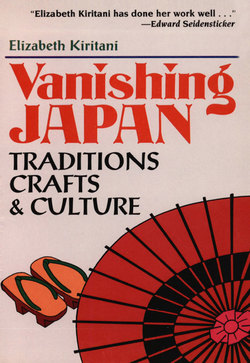Читать книгу Vanishing Japan - Elizabeth Kiritani - Страница 12
ОглавлениеPipe Cleaners
Tobacco made its way to Japan from America via the Portuguese and Spaniards at the end of the sixteenth century. It was extolled for its medicinal properties-. "If a sick man tastes this smoke he is restored to glowing health," wrote Prince Toshihito in 1609. Times have changed for tobacco. And so have the ways of smoking it.
Cigars appear to have come first. The record is sketchy, but soon a long thin pipe called a kiseru became de rigueur for men and women of all strata in Japan, despite sporadic and futile government intervention.
Among other things, smoking was thought to help fix the black color that married women applied to their teeth, giving the kiseru allure as an odd sort of beauty aid. Shopkeepers smoked kiseru with flat mouthpieces that teeth could clamp down on to free hands for business; the samurai's was thin and elegant; the sumo wrestler's huge; the actor's distinctive and easily recognized. At one point some townspeople brandished heavy, studded kiseru called "squabble pipes" as substitutes for the swords they were not permitted to carry.
Materials for the bowl and mouthpiece of the kiseru included ceramics, stone, ivory, silver, and gold, but copper was the most prevalent. These ends were joined by a stem of bamboo. Raoya, the name for men who clean and refit the bamboo, bowl, and mouthpiece of kiseru, comes from the word for Laos, where this bamboo was originally from. Kiseru is a Cambodian word. Just why such a word came to be used for Japanese pipes remains unclear.
Tomeshiro Nakajima, like his father before him, has been servicing kiseru for forty-six years. If you visit Asakusa's Kannon Temple on a weekend, you may run into him, the very last raoya, or kiseru cleaner, in Japan.
He takes up a spot in front of the main gate of the temple, in an indigo coat and straw hat with a long kiseru pipe in hand, looking like something right out of the Edo Period. He'll be leaning on his stalwart bicycle whose sidecart forms a wooden store with glass windows protecting a row of antique kiseru. Inside also is a peculiar potbellied stove. A wooden shelf folds out to one side proffering less expensive kiseru and the pale kiseru tobacco to the hands of the masses. Some of this tobacco lies out in a bowl from which Mr. Nakajima fills and refills his long pipe. Different from cigarette or cigar tobacco, this kizami is chopped into fine hair-like strands.
The storecart has a roof from which three odd chimneys jut, gaily puffing out smoke. Two are whistles and the third serves as an outlet for the potbellied stove. This stove contains the charcoal upon which Mr. Nakajima lights his long kiseru. It also holds a compartment of boiled water to flush out clogged pipes. When a lever is pulled, steam whooshes out one or the other of the whistles making a high-pitched sound to announce his proximity or a soft lower sound to signal that he has stopped somewhere. In the past, regular customers would recognize his particular sound and run out to catch him.
These days, of course, there are not many people wanting their kiseru cleaned or bamboo refitted. That's not to say that people don't use kiseru, reassures Mr. Nakajima. It's just that they use cheaper ones which they can throw out once the geriatric symptoms of stenosis appear.
Until recently, Mr. Nakajima's business was almost exclusively repairing pipes. Drawers in his cart still burst with tools—long rods to push out black worms of tar, saws and knives to fit bamboo snugly to bowl and mouthpieces. His heyday was just before and after the war because when tobacco became scarce, real addicts didn't want to dilute it by smoking it with paper. Nowadays, it's a rare pipe he fixes. But he has a brisk business in cheap kiseru sales.
His customers vary, I saw as I watched him work one chilly March afternoon. Mr. Nakajima enjoys interaction with people, be they natives or foreigners. Language is no barrier. He finds a friendly way to communicate by offering a toke off his pipe to a curious foreigner, or by sharing reminiscences with a lingering elder. Wham, wham—he knocks the remnants out of the bowl of his pipe, smiling all the while with the brown teeth of a connoisseur. He puffs on Virginia Slims between pipes.
People come and go. Whenever one person stops to look, a whole swarm joins. An eager look flickered across one Middle Easterner's face when he saw the kizami. "Hashish?" he queried hopefully. "Try it and see," laughed back Mr. Nakajima in a jumble of English, Japanese, and gesticulation. A purchase. An elderly woman in kimono appeared. "My mother used one," she commented. "Not like these, but a smaller, thinner one which she wrapped in cloth before placing it in her obi." A purchase. The most surprising buyer, though, was a middle-aged man, wife and child in tow, who wandered over, glanced at the case of antique kiseru, and, with little more than a nod, bought the silver-tipped one for 20,000 yen. Mr. Nakajima concurs that business these days is pretty good.
